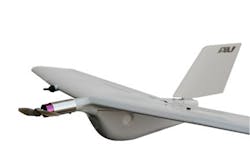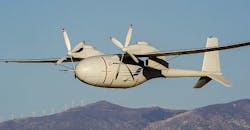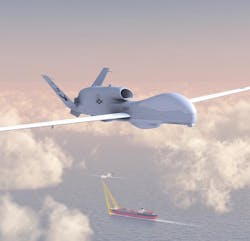AUVSI general counsel provides update on unmanned aerial system integration into public airspace
LAS VEGAS, 6 March 2013. U.S. airspace integration will create more than 34,000 manufacturing jobs and more than 70,000 new jobs in the first three years, predicts Ben Gielow, government relations manager and general counsel at Association of Unmanned Vehicle Systems International (AUVSI) at Heli-Expo 2013 in Las Vegas.
The Federal Aviation Administration (FAA) considers an unmanned aerial system (UAS) an aircraft, he says, and once it is defined as an aircraft, all FAA rules apply. UAS are not yet certified (no standards). Work being done on sense-and-avoid systems; the goal: to know where everyone is at all times.
We are in what the FAA calls the “Accommodation Phase” with only three options: experimental certification, special use airspace (DOD owned and operated), and waivers (Certificate of Authorization, COA), Gielow explains.
The DOD has roughly 900 unmanned aerial systems and trains more unmanned operators than manned pilots. The trend is just going to continue, Gielow says.
When it comes to certification, one size should not fit all, he adds. Unmanned systems from a four-pound UAS to the 23,000-pound Global Hawk should not be grouped together and handled the same way.
The FAA has missed several deadlines dictated by the U.S. Congress related to the safe and efficient integration of unmanned aerial systems (UAS) in public airspace, including expediting COAs, the selection of six UAS test sites, and the development of a comprehensive integration plan, and production of a five-year roadmap. “It’s a significant challenge for the FAA, and we’re not minimizing that,” Gielow says.
Outstanding issues include, among others:
Standards
Definitions
Sense and avoid
Aircraft certification
Operator training and certfici9ation
Air traffic requirements
Spectrum allocation
Secure command and control links
Secure GPS
Insurance
Public opinion
Privacy is a major issue. “So far this year, 26 states have introduced UAS privacy legislation,” Gielow explains. Federal legislation introduced in 2012 includes 12 items, from 11 Republican representatives and one Democratic representative, he points out, related to UAS and privacy. The existing legal framework already in place is a good place to start, he says, stressing that privacy is not the FAA’s responsibility. AUVSI is working on a strategy to address privacy issues.


